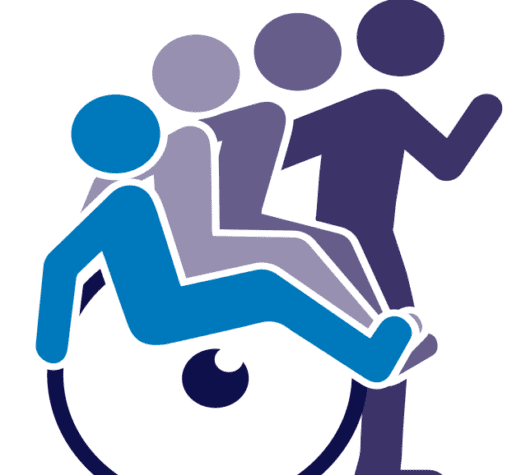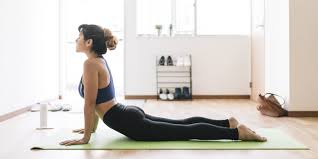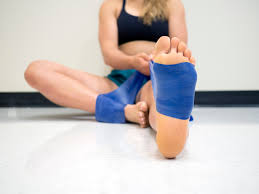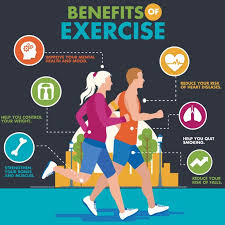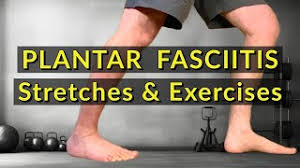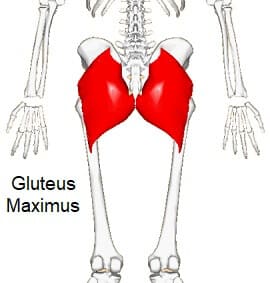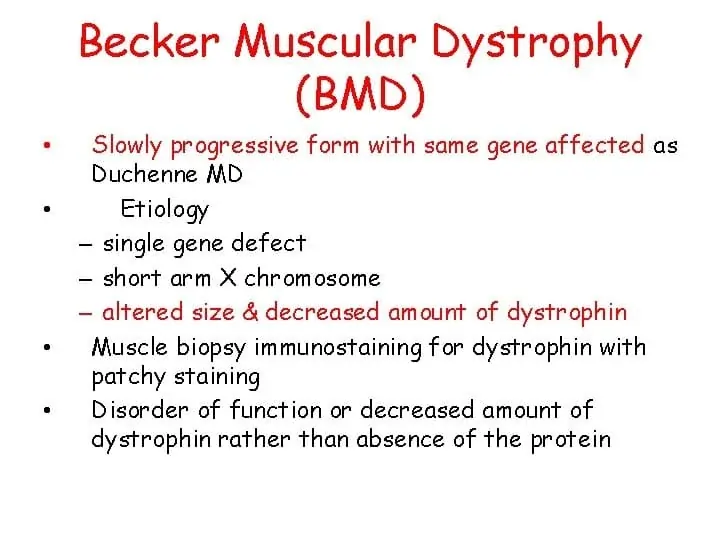Effective Physical Therapy Exercises for Lower Back Pain
Table of Contents
Introduction:
One of the most prevalent musculoskeletal conditions that affects people of all ages is lower back pain. It may be caused by injury, a sedentary lifestyle, weak muscles, or bad posture. Good physical therapy exercises are essential for reducing pain, increasing range of motion, and fortifying the muscles supporting the spine.
By encouraging improved posture and general spinal health, these exercises not only lessen pain but also help avoid recurring attacks.
Benefits of Physical Therapy Exercises for Lower Back Pain:
- Pain Relief: Specific exercises can help ease acute or chronic lower back pain by reducing muscle tension.
- Increased Flexibility: Mobility exercises and stretches increase the spine’s and the surrounding muscles’ range of motion.
- Strengthening Muscles: By strengthening the hip, back, and core muscles, the spine is better supported.
- Posture Correction: Consistent exercise helps keep the spine in the right alignment, which lessens the strain caused by bad posture.
- Preventing Future Injuries: Recurring pain is less likely when the muscles surrounding the lower back are strengthened and stabilized.
- Improved Daily Function: Makes it easier to carry out daily tasks without experiencing pain.
- Decreased Dependency on Medication: Exercises that don’t include any physical contact can help reduce the need for painkillers and other medications.
Effective Physical Therapy Exercises for Lower Back Pain Video:
Exercises for Lower Back Pain:
Knee-to-Chest Stretch:
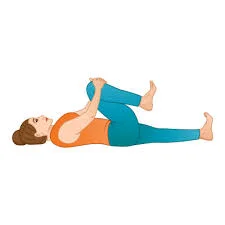
A straightforward yet powerful exercise for reducing lower back strain and increasing flexibility is the knee-to-chest stretch. To do it, place your feet flat on the floor and bend your knees while lying on your back.
Keeping the other foot stationary, slowly raise one knee toward your chest while gripping it with both hands. This stretch is particularly helpful for people who are having lower back pain since it lengthens the lower back muscles, eases stiffness, and improves spinal mobility.
Cat-Cow stretch:
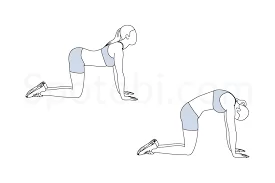
The Cat-Cow stretch is a soft, flowing practice that relieves neck and back stress and increases spine mobility and flexibility. With your knees beneath your hips and your hands directly beneath your shoulders, start on all fours.
Exhale as you round your spine, tucking your chin and pelvis (Cat posture), and inhale as you arch your back, lifting your head and tailbone toward the ceiling (Cow stance). For eight to ten cycles, carefully repeat this action. This stretch improves circulation to the spine, increases spinal flexibility, and eases lower back pain and stiffness.
Bird Dog exercise:
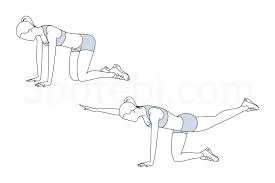
A great exercise for strengthening the lower back, core, and stabilizing muscles is the Bird Dog. Place your knees beneath your hips and your hands beneath your shoulders to begin on all fours. Maintaining a neutral spine and level hips, slowly stretch your left leg backward and your right arm forward.
By activating and strengthening the muscles that support the spine, 10–12 repetitions on each side can help reduce lower back pain while also enhancing balance, coordination, and spinal stability.
Bridge exercise:
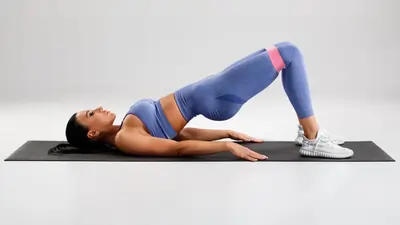
The glutes, lower back, and core muscles—all crucial for supporting the spine—can be strengthened with the help of the Bridge exercise. To raise your hips toward the sky and create a straight line from your shoulders to your knees, push through your heels. After holding for a short while, carefully bring your hips back down.
Repeating this 10 to 15 times strengthens and activates the muscles supporting the lower spine, improving overall posture, lowering pain, and increasing lower back stability.
Superman exercise:
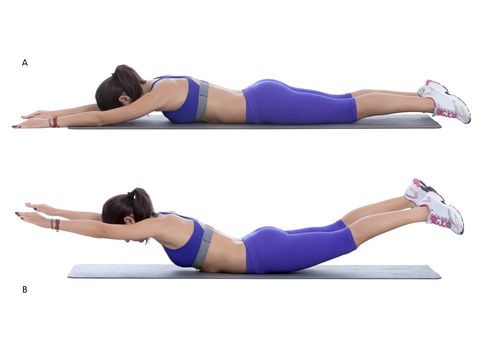
Strengthening the lower back, glutes, and core muscles—all essential for posture and spinal support—is the goal of the Superman exercise. It is performed by lying face down on the floor with your legs straight and your arms out in front of you. Using your back muscles, raise your arms, chest, and legs as high off the ground as you can comfortably do all at once.
After a few seconds of holding this position, carefully lower yourself back down. Ten to twelve repetitions of this exercise increase general strength in the muscles supporting the spine, decrease lower back stiffness, and improve spinal stability.
Hip Extension exercise:

To support and maintain the spine, the Hip Extension exercise works the glutes, hamstrings, and lower back muscles. You do it by lying face down on the floor with your arms by your sides and your legs straight. Using your glutes and lower back, slowly raise one leg off the ground while maintaining a straight posture.
After a few seconds of holding, drop it back down and move on to the other leg. Back pain can be effectively relieved and prevented by performing 10–12 repetitions on each side, which also enhances hip mobility, strengthens the posterior chain, and lessens tension on the lower back.
Child’s Pose stretch:
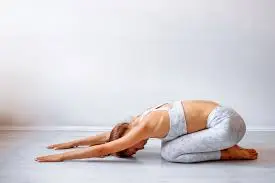
A mild yoga-based stretch that eases stress in the thighs, hips, and lower back is called “Child’s Pose.” To do it, spread your knees apart and kneel on the floor with your big toes touching. Lower your chest toward the floor while extending your arms forward on the floor, while sitting back on your heels.
While taking deep breaths, hold this position for 20 to 30 seconds. This stretch is particularly helpful for lowering lower back pain and calming the body since it softly lengthens the spine, eases tense muscles, and increases flexibility.
Glute Stretch:
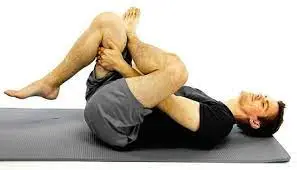
By relieving stress in the gluteal and lower back muscles, the Glute Stretch is a helpful exercise that can improve hip mobility and reduce pain. To perform it, lie on your back with your feet flat on the floor and bend your knees. Cross your right ankle over your left knee to make a figure-four.
Then, slowly raise your left thigh to your chest until your right glute feels stretched. Change sides after 20 to 30 seconds of holding. Regular use of this stretch relieves tight glutes, reduces lower back pain, and supports proper pelvic alignment.
Cobra Pose:

The Cobra Pose is a mild backbend that helps release lower back tightness, extend the chest and abdominal muscles, and strengthen the spine. To execute it, place your hands beneath your shoulders and extend your legs while lying face down on the floor. With your elbows slightly bent and your shoulders relaxed, push through your palms to raise your chest off the floor.
Breathe deeply as you hold the stance for 15 to 30 seconds, then slowly lower yourself back down. In addition to strengthening the lower back muscles and increasing spinal flexibility, this exercise can help ease the pain caused by extended sitting or bad posture.
Conclusion:
Lower back pain can be effectively managed and prevented by including physical therapy exercises in your routine. Core and back muscles are strengthened, flexibility is increased, and good posture is encouraged with exercises including knee-to-chest stretches, Cat-Cow, Bird Dog, Bridge, Superman, Hip Extension, Child’s Pose, Glute Stretch, and Cobra Pose.
Frequent practice improves spine stability, lowers the chance of further injuries, and promotes general functional mobility, all of which help you do daily tasks more comfortably and easily.
FAQs
There are five vertebrae in your lower back. Ligaments hold the vertebrae in place, tendons connect muscles to the spinal column, and discs between them cushion the bones. There are 31 nerves in the lower back. Additionally, your lower back is home to organs like the kidneys, pancreas, colon, and uterus.
Back pain can manifest in a variety of ways, ranging from muscle tightness to a burning, stabbing, or shooting feeling. Radiating pain may also be felt in a leg. Bending, twisting, raising, standing, and walking may worsen pain.
From muscle soreness to a scorching, stabbing, or shooting sensation, back pain can take many forms. Additionally, a leg may experience radiating pain. Pain can worsen when you bend, twist, raise, stand, or walk.
However, as strength and mobility improve with each session, patients can anticipate spending an average of six to eight weeks in physical therapy. Physical treatment can take longer or be suggested following surgery if your back pain is still severe or worse.
While disc pain is usually stronger, shooting, and can radiate to the legs or buttocks, often with numbness or tingling, muscle pain feels like a dull ache that gets better with rest and can induce muscular spasms. To distinguish, take note of the type of pain, where it occurs (muscle pain is frequently on the sides of the spine), and whether it gets worse as you bend or raise. Seek medical help right away if the pain is severe, ongoing, or accompanied by neurological signs like loss of bladder control.
The most common cause of acute low back pain is an abrupt damage to the back’s supporting muscles and ligaments. Muscle spasms or a strain or rupture in the muscles and ligaments could be the source of the pain. Compression fractures of the spine are among the causes of abrupt low back pain.
The ideal sleeping position for back pain is usually on your side with a pillow between your knees to keep your hips and pelvis in alignment, or on your back with a pillow beneath your knees to preserve the natural curve of your spine and even weight distribution. For side sleepers, a full-length body pillow can also offer superior support.
The McKenzie method (back extensions), core-stabilizing planks, bridges, pelvic tilts, and the cat-camel stretch are among the best exercises for the L4-L5 region, such as for a disc bulge. These exercises emphasize core strengthening and moderate spinal mobilization. Yoga, swimming, and other mild, low-impact exercises are also helpful. Before beginning any new fitness program, it is imperative to speak with a physician or physical therapist to make sure it is safe for your particular condition and to avoid exercises like heavy deadlifts that might worsen a L4-L5 disc bulge.
Avoid workouts like sit-ups, deadlifts, burpees, standing toe touches, and cobra stretches that require extensive bending or spinal extension, heavy lifting, twisting the spine, and high-impact activities. Instead, under the supervision of a physical therapist who will develop a customized therapy plan, concentrate on low-impact exercises like swimming, walking, and mild strength training.
The “best” physiotherapy for lower back pain is not a single treatment but rather a customized mix of manual therapy, mobility and strengthening exercises, and posture and lifestyle instruction. To address the particular reasons for your pain, this frequently include methods like joint mobility, soft tissue mobilization, customized stretching and core strengthening exercises, TENS (for pain), and ergonomic guidance.
Use over-the-counter pain medicines like ibuprofen, stay active with light movement, and apply ice for the first 48 to 72 hours before using heat to speed up the healing process for lower back pain. Relief can also be obtained by strengthening core muscles, keeping proper posture, and engaging in mild stretching. Seek immediate medical attention if you are experiencing extreme pain or agony after an injury.
When sitting, make sure your back is supported and straight by using pregnancy support pillows. Obtain adequate sleep, especially in the latter stages of pregnancy. Take a warm bath or get a massage. Use a mattress that provides adequate support for you; if necessary, place a piece of hardboard below a soft mattress to firm it up.
Gentle stretches (like the Knee-to-Chest Stretch and Cat-Cow), core strengthening exercises (like Pelvic Tilts and Bridges), and low-impact aerobic activities (like walking) are all effective ways to relieve lower back pain. However, it’s important to avoid sharp pain and seek advice from a healthcare provider for a customized exercise regimen.
References:
- Back exercises in 15 minutes a day. (n.d.-h). Mayo Clinic. https://www.mayoclinic.org/healthy-lifestyle/adult-health/in-depth/back-pain/art-20546859
- Sfma, K. B. P. D. O. (2024b, October 25). Stretches and Exercises for Lower Back Pain, from a PT. Hospital for Special Surgery. https://www.hss.edu/health-library/move-better/exercises-for-lower-back-pain
- Physical therapy for lower back pain – 10 best exercises for relief. (n.d.-b). https://www.movementforlife.com/articles/physical-therapy-lower-back-pain-10-best-exercises-relief
- Physio, B. (2025d, June 30). 13 exercises for lower back pain that you can do anywhere. Benchmark Physio. https://benchmarkphysio.com.au/physiotherapy-exercises-for-lower-back-pain/
- Freutel, N. (2024, August 2). 5 Strengthening exercises for lower back pain. Healthline. https://www.healthline.com/health/fitness-exercise/lower-back-exercises
- Clinic, I. (2025, June 4). Stretch and strengthen your way out of lower back pain. The Iowa Clinic. https://www.iowaclinic.com/specialties/bone-joint/physical-therapy/stretch-and-strengthen-your-way-out-of-lower-back-pain/
